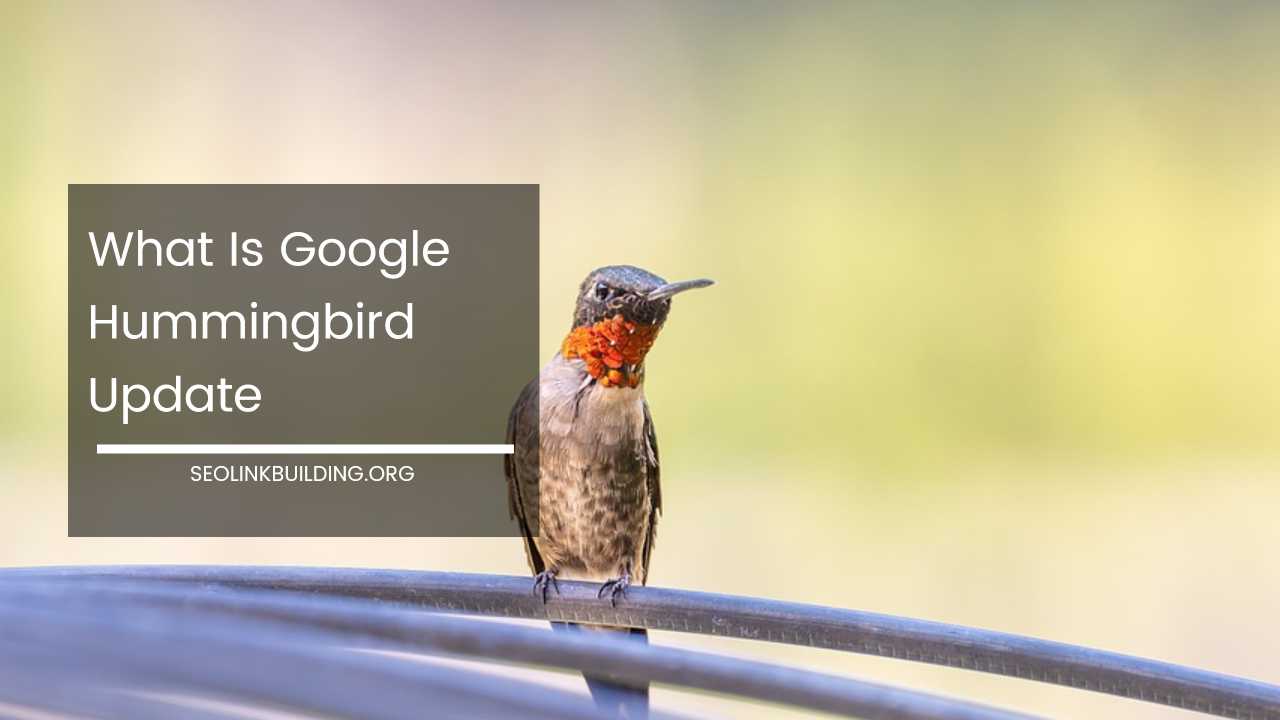How Did the Google Hummingbird Update Change Search?

What Is Google Hummingbird Update: A Deep Dive into Semantic Search
In the ever-evolving landscape of search engine optimization (SEO), understanding foundational algorithm updates is crucial for crafting content that ranks well.
One such landmark update is Google Hummingbird, which revolutionized how search engines interpret user queries and deliver results.
Launched in 2013, Hummingbird marked a significant shift from keyword-focused matching to a more nuanced understanding of searcher intent and semantic meaning.
This article delves into the intricacies of the Google Hummingbird update, exploring its impact on SEO practices and how you can optimize your content for the current search landscape.
Understanding Hummingbird: From Keywords to Context
Prior to Hummingbird, search engine algorithms relied heavily on keyword matching. Content creators would strategically place keywords throughout their webpages, often leading to keyword stuffing and content that felt robotic and unnatural.
Hummingbird ushered in a new era of semantic search, where the emphasis shifted to understanding the context and meaning behind a search query.
Here’s how Hummingbird transformed search:
- Focus on Intent: Instead of simply matching keywords, Hummingbird analyzes the entire query, considering the searcher’s intent. For example, a query like “best laptops for students” is interpreted as a search for recommendations, not just a list of laptops containing those keywords.
- Understanding Relationships: Hummingbird factors in the relationships between words in a search query. This allows it to grasp the nuances of language and identify synonyms and related concepts. For example, a search for “healthy recipes” might also surface results for “nutritious meals” or “low-calorie cooking.”
- Entity Recognition: Hummingbird recognizes real-world entities like people, places, and things mentioned in a query. This helps it connect searches to relevant information on the web. For instance, a search for “Mount Everest” would not only return results about the mountain itself but also information on climbing expeditions, weather conditions, and nearby attractions.
- Conversational Search: Hummingbird paved the way for conversational search, allowing users to interact with search engines in a more natural language format. This opened doors for voice search advancements like Google Assistant. Imagine asking “What are the best places to visit in Italy?” instead of typing out a keyword-heavy query.
The Impact of Hummingbird on SEO: A Broader Look
The introduction of Hummingbird necessitated a paradigm shift in SEO practices. Keyword stuffing became obsolete, and content creators had to prioritize creating high-quality content that addressed the user’s intent and provided value. Here’s a breakdown of Hummingbird’s impact on SEO, delving deeper into some aspects:
- Content Quality: The focus shifted to creating informative, well-written content that resonates with the target audience. Keyword research remained important, but it became a tool for understanding user intent rather than a content creation crutch. Instead of simply cramming keywords into a blog post, you’d research what users are looking for when they search for those keywords and tailor your content to answer their questions and provide solutions to their problems.
- Topic Clusters and Content Silos: Hummingbird’s ability to understand relationships between keywords encouraged the creation of topic clusters and content silos. A topic cluster is a group of content pieces that all focus on a central theme but cover different aspects of that theme. Content silos are similar, but they are typically organized around a specific product or service category on a website. For example, if you have a website about pet care, you could create a topic cluster on dog training with separate blog posts on puppy training, obedience training, and housebreaking. This allows you to create comprehensive information hubs on specific topics, improving your website’s authority and ranking potential in the eyes of search engines.
- Long-Tail Keywords: Hummingbird’s emphasis on natural language queries led to a rise in long-tail keywords – more specific phrases users employ in their searches. Optimizing content for long-tail keywords became a valuable strategy for targeting niche audiences and improving search ranking. Instead of trying to rank for the highly competitive keyword “dog food,” you might target long-tail keywords like “best organic dog food for puppies with sensitive stomachs.”
- User Experience (UX): Hummingbird indirectly influenced the importance of UX in SEO. Content that is well-structured, easy to navigate, and mobile-friendly became crucial for keeping users engaged and satisfying Google’s search algorithms. This means ensuring your website loads quickly, has a clear and logical layout, and is optimized for viewing on all devices.
Optimizing Your Content for the Hummingbird Era: Practical Strategies
By understanding the core principles of Hummingbird, you can craft content that caters to the modern search landscape. Here are some actionable tips for optimizing your content, along with some additional considerations:
- Focus on User Intent: Conduct thorough keyword research using tools like Google Keyword Planner or SEMrush to understand what users are searching for and the intent behind their queries. Don’t just stop at the keywords themselves; delve into the “why” behind the search. Are users looking for information, trying to compare products, or seeking to complete a specific action? Answering these questions will guide your content strategy and ensure you’re creating content that truly resonates with your target audience.
-
Create In-Depth Content: Move beyond keyword stuffing and create comprehensive content that addresses the user’s needs and provides valuable information. Think about the questions your target audience might have on a particular topic and answer them in a clear, concise, and engaging way. For instance, if you’re writing a blog post about “how to change a car tire,” don’t just list the steps. Include visuals like images or even a video walkthrough. Explain the reasons behind each step and troubleshoot common problems users might encounter.
-
Target Long-Tail Keywords: Incorporate long-tail keywords naturally into your content to target specific user searches and improve ranking potential. Long-tail keywords are less competitive than head keywords (broad, single words) and offer a higher chance of converting users who are further along in the buying journey. Use long-tail keywords throughout your content, including headings, subheadings, and the body text itself. However, prioritize using them naturally; don’t force them in a way that disrupts the flow of your writing.
-
Structure Your Content Logically: Organize your content with clear headings, subheadings, and bullet points for better readability and user experience. This not only improves the user experience but also helps search engines understand the structure and hierarchy of your content.
-
Optimize for Mobile: Ensure your website and content are mobile-friendly, as a significant portion of searches now occur on smartphones and tablets. Use responsive design principles to ensure your website adapts to different screen sizes and provides an optimal viewing experience on all devices.
-
Build Topic Clusters: Develop content clusters that explore various aspects of a central theme, providing users with a comprehensive understanding of a subject. This approach establishes your website as a trusted authority on a particular topic and can significantly improve your ranking potential for relevant keywords.
-
Incorporate Multimedia: Include relevant images, videos, and infographics to enhance user engagement and cater to different learning styles. People process information visually, so using multimedia breaks up text-heavy content and makes it more visually appealing.
-
Maintain Content Freshness: Regularly update your content with new information and insights to keep it relevant and valuable to users. Search engines favor fresh content, and updating existing content shows Google that your website is active and maintained.
-
Go Beyond On-Page SEO: While on-page SEO (optimizing your website itself) is crucial, Hummingbird also emphasizes off-page SEO factors like building backlinks from high-quality websites. Backlinks act as votes of confidence for your website in the eyes of search engines and can significantly improve your ranking.
The Future of Search: Beyond Hummingbird
Hummingbird stands as a pivotal moment in search engine history. By prioritizing semantic understanding and user intent, it ushered in an era of more sophisticated and user-friendly search experiences.
As search continues to evolve, focusing on creating high-quality, informative content that caters to user needs remains paramount for SEO success. Here are some additional trends to keep on your radar:
- The Rise of Voice Search: With the growing popularity of smart speakers and virtual assistants, voice search is becoming increasingly important. Optimizing your content for natural language queries will be crucial for reaching users who prefer to search using voice commands.
- Artificial Intelligence (AI) and Machine Learning: Search engines are constantly evolving with the help of AI and machine learning. These technologies allow search engines to better understand the nuances of human language and user intent, leading to even more personalized search results.
- The Focus on Entity Search: Search engines are placing greater emphasis on understanding the relationships between entities (people, places, things) mentioned in search queries. This means creating content that is well-connected to relevant entities and provides a comprehensive understanding of a topic.
By staying updated on these trends and continuing to create high-quality, user-centric content, you can ensure your website thrives in the ever-changing landscape of search engine optimization.
Remember, SEO is a marathon, not a sprint. By consistently implementing these strategies and adapting to future advancements, you can position your website for long-term success in the eyes of both search engines and users.












